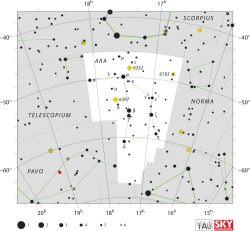Gamma Arae
| Observation data Epoch J2000 Equinox J2000 |
|
|---|---|
| Constellation | Ara |
| Right ascension | 17h 25m 23.65931s |
| Declination | –56° 22′ 39.8148″ |
| Apparent magnitude (V) | 3.34 |
| Characteristics | |
| Spectral type | B1 Ib |
| U−B color index | –0.96 |
| B−V color index | –0.13 |
| Astrometry | |
| Radial velocity (Rv) | –3 km/s |
| Proper motion (μ) |
RA: –0.44 mas/yr Dec.: –15.77 mas/yr |
| Parallax (π) | 2.93 ± 0.16mas |
| Distance | 1,110 ± 60 ly (340 ± 20 pc) |
| Absolute magnitude (MV) | –5.8 |
| Details | |
| Mass | 12.5–25 M☉ |
| Radius | 23 R☉ |
| Luminosity | 120,000 L☉ |
| Surface gravity (log g) | 2.90 cgs |
| Temperature | 21,500 K |
| Rotation | 4.8 |
| Rotational velocity (v sin i) | 269 ± 11 km/s |
| Age | 15.7 ± 0.1 Myr |
| Other designations | |
| Database references | |
| SIMBAD | data |
Gamma Arae (γ Ara, γ Arae) is a star in the southern constellation of Ara. With an apparent visual magnitude of 3.3, it is the fourth-brightest star in the constellation and is readily visible to the naked eye. From parallax measurements made during the Hipparcos mission, the distance to this star can be estimated as 1,110 light-years (340 parsecs) from Earth.
This is an enormous star with 23 times the radius of the Sun. It is radiating 120,000 as much energy as the Sun from its outer envelope at an effective temperature of 21,500 K. This heat gives the star the blue-white glow of a B-type star. The spectrum shows it to match a stellar classification of B1 Ib, with the luminosity class of 'Ib' indicating this is a lower luminosity supergiant star. It is a relatively young body, with an estimated age of around 15.7 million years.
Gamma Arae is rotating rapidly with a projected rotational velocity of 269 km s−1, causing it to complete a full rotation about every 4.8 days. In the spectrum of this star, this high rate of spin is causing absorption lines to blend together because of the Doppler effect, making them more difficult to analyze. It is a periodically variable star that undergoes non-radial pulsations with a primary period of 1.1811 days and a secondary period of 0.1281 days.
...
Wikipedia

